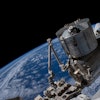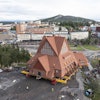App Drives, Summons Self-Driving Cars
Korean electric vehicle manufacturer IT Engineering has partnered with researchers at the Electronics and Telecommunications Research Institute (ETRI) to create an app that can be used to control a self-driving car.
As you can see from the video, the small, two-seater smart car isn't going anywhere too quickly, but the software allows the user to not only call a self-driving car, but move it as well. The software enables the car to use sensors to produce and update a precise map of its surroundings in real-time, with an error rate of 10 centimeters — or nearly 4 inches.
The researchers have also managed to do all of this with a drastic power reduction. Because of the sheer amount of sensors and equipment, self-driving car concepts can require hundreds of watts of electricity. ETRI's application uses less than 100 Watts, about the equivalent of two laptops.
Next, the team is working on integrating deep learning, but does plan on sharing its data with other self-driving researchers and developers.
World’s Largest Paper Ball
At IMTS 2018 in Chicago, NC-based InspectionXpert, a company that specializes in inspection planning software, announced that the company had been acquired by UK-based global tech company Ideagen for $7 million.
Admittedly, that wasn't what made me stop at the booth. Rather, it was the massive paper ball that looked like it was poised to crush the poor guys working the booth at any moment.
It turns out that this PR stunt still has some legs as it just set the Guinness World Record for the World's Largest Paper Ball. What’s interesting is that this incredible waste of paper was created to show how paper creates a lot of waste, since InspectionXpert is a paperless solution. Staff at InspectionXpert created the giant ball to bolster its message of reducing paper and inefficiency in the manufacturing inspection process.
The previous record was set by the Minnesota Pollution Control Agency in St. Paul in August 2014. Their paper ball weighed 426 lbs, was made from recycled paper and was 10.27 feet in diameter.
The new record holder is made from cardboard, paper and paper cord. It weighs 576 lbs, it's only 9'8.6" tall, but is 33' around. The ball was confirmed as the world's largest after a stringent review period.
The giant paper ball didn’t use any tape or glue, only paper products that were sourced from local schools. The internal structure was made of honeycomb cardboard while the outside of the ball was covered with a net made from brown paper cord. According to the company, the ball was recycled after the weighing, which just seems like a missed opportunity. People travel across the world to see things like the World’s Largest Paper Ball — might’ve even had a write up in Atlas Obscura.
InspectionXpert founder Jeff Cope said, “We wanted to do something ridiculous to highlight how preposterous paper is in 2018 when there are more efficient solutions.” Well Jeff, you nailed it.
SpaceX Mission Rescheduled Due to Moldy Mice Food
Spacecraft launches can be postponed for any number of reasons: weather and equipment problems being two of the most common. This week, a SpaceX Dragon launch was pushed back after mold was found on food bars.
It's understandable that a resupply mission is essentially worthless if some of the supplies are rotten, but the particular food bars in question were earmarked for rats. They were going to be used for an experiment on the International Space Station, so the entire launch had to be pushed just to replace the food bars.
On December 5th, the two-stage Falcon 9 launch vehicle lifted off from Cape Canaveral with a nearly 6,000 pound package aboard the Dragon spacecraft. It is SpaceX's 16 commercial cargo mission to resupply the space station.
Aboard the Dragon spacecraft are experiments such as the Robotic Refueling Mission 3 (RRM3) that will work on the storage and transfer of cryogenic fluid, which is used for propulsion and life support systems; and the Global Ecosystem Dynamics Investigation (GEDI) system, which takes high-quality laser ranging observations of Earth’s forests and topography to better understand carbon and water cycling processes and biodiversity.
Oh, and don't forget the fresher food bars for the mice.
SpaceX, which is known for reusing rockets, actually crashed its first Falcon 9 since 2015. The company disrupted the the commercial space market by successfully reusing rockets, which presented a tremendous cost savings.






















